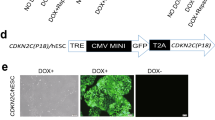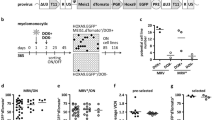Abstract
HOXB4 overexpression mediates increased self-renewal of haematopoietic stem cells (HSCs) ex vivo. Since HOXB4-expanded HSCs retain normal differentiation potential and there is no leukaemia development from transduced HSCs, HOXB4 represents a promising tool for human HSC therapy. However, the increased proliferation capacity of HOXB4 overexpressing fibroblasts resulting from upregulation of JunB, Fra-1 and cyclin D1 protein levels may indicate a potential risk associated with the HOXB4 overexpression approach. This prompted us to investigate the proliferation rate, differentiation and expression of cell cycle regulators directly in bone marrow cultures overexpressing HOXB4. Here we show that in comparison to neo-transduced control bone marrow cultures, HOXB4-overexpressing cultures had a more homogenous morphology and increased numbers of haematopoietic progenitor cells capable to generate primitive colonies in vitro. In contrast, neo-transduced bone marrow cells in long-term cultures showed hallmarks of myeloid differentiation and a reduced secondary colony forming activity. We further show that multilineage repopulating activity in vivo, which was present only in HOXB4 long-term cultures, declined over time. HOXB4 overexpression in vitro did not result in an increase but in a stabilization of the proliferation rate (1.4–1.8 cell divisions per day), while the proliferation rate of control neo-transduced bone marrow cultures gradually declined. Correspondingly, increased HOXB4 expression was paralleled by decreased expression levels of cyclins, CDKs and AP-1 family members. These results suggest that the growth rate of HOXB4- compared to neo-transduced bone marrow cells remains constant in long-term cultures along with a suppression of myeloid differentiation. In contrast to HOXB4 overexpression in fibroblasts, bone marrow cells engineered to overexpress HOXB4 do not upregulate AP-1 complex members or cyclins indicating that HOXB4 acts in a cell type-specific way.
This is a preview of subscription content, access via your institution
Access options
Subscribe to this journal
Receive 50 print issues and online access
$259.00 per year
only $5.18 per issue
Buy this article
- Purchase on Springer Link
- Instant access to full article PDF
Prices may be subject to local taxes which are calculated during checkout






Similar content being viewed by others
References
Amsellem S, Pflumio F, Bardinet D, Izac B, Charneau P, Romeo PH, Dubart-Kupperschmitt A and Fichelson S . (2003). Nat. Med., 9, 1423–1427.
Antonchuk J, Sauvageau G and Humphries RK . (2001). Exp. Hematol., 29, 1125–1134.
Antonchuk J, Sauvageau G and Humphries RK . (2002). Cell, 109, 39–45.
Bhardwaj G, Murdoch B, Wu D, Baker DP, Williams KP, Chadwick K, Ling LE, Karanu FN and Bhatia M . (2001). Nat. Immunol., 2, 172–180.
Brun A, Fan X, Björnsson J, Humphries RK and Karlsson S . (2003). Mol. Ther., 8, 618–628.
Bunting KD, Galipeau J, Topham D, Benaim E and Sorrentino BP . (1998). Blood, 92, 2269–2279.
Buske C, Feuring-Buske M, Abramovich Cea, Spiekermann K, Eaves CJ, Coulombel L, Sauvageau G, Hogge DE and Humphries RK . (2002). Blood, 100, 862–868.
Conneally E, Cashman J, Petzer A and Eaves C . (1997). Proc. Natl. Acad. Sci. USA, 94, 9836–9841.
Dai M-S, Mantel CR, Xia ZB, Broxmeyer HE and Lu L . (2000). Blood, 96, 3985–3987.
de Haan G, Weersing E, Dontje B, van Os R, Bystrykh LV, Vellenga E and Miller G . (2003). Dev. Cell, 4, 241–251.
Furukawa Y . (2002). Leukemia Lymphoma, 43, 225–231.
Israels ED and Israels LG . (2001). Stem Cells, 19, 88–91.
Krosl J and Sauvageau G . (2000). Oncogene, 19, 5134–5141.
Krosl J, Austin P, Beslu N, Kroon E, Humphries RK and Sauvageau G . (2003). Nat. Med., 9, 1428–1432.
Krosl J, Baban S, Krosl G, Rozenfeld S, Largman C and Sauvageau G . (1998). Oncogene, 16, 3403–3412.
Loeffler M and Roeder I . (2002). Cells Tissues Organs, 171, 8–26.
Lyons AB and Parish CR . (1994). J. Immunol. Methods, 171, 131–137.
Mathas S, Hinz M, Anagnostopoulos I, Krappmann D, Lietz A, Jundt F, Bommert K, Mechta-Grigoriou F, Stein H, Dorken B and Scheidereit C . (2002). EMBO J., 21, 4104–4113.
Moore KA, Ema H and Lemischka IR . (1997). Blood, 89, 4337–4347.
Murdoch B, Chadwick K, Martin M, Shojaei F, Shah KV, Gallacher L, Moon RT and Bhatia M . (2003). Proc. Natl. Acad. Sci. USA, 100, 3422–3427.
Oostendorp RA, Audet J and Eaves CJ . (2000). Blood, 95, 855–862.
Oostendorp RA, Harvey KN, Kusadasi N, de Bruijn MF, Saris C, Ploemacher RE, Medvinsky AL and Dzierzak EA . (2002). Blood, 99, 1183–1189.
Passegue E and Wagner EF . (2000). EMBO J., 19, 2969–2979.
Passegue E, Jochum W, Schorpp-Kistner M, Mohle-Steinlein U and Wagner EF . (2001). Cell, 104, 21–32.
Pawliuk R, Eaves C and Humphries RK . (1996). Blood, 88, 2852–2858.
Randall TD and Weissman IL . (1997). Blood, 89, 3596–3606.
Rowlands TM, Pechenkina IV, Hatsell S and Cowin P . (2004). Cell Cycle, 3, 145–148.
Sauvageau G, Thorsteinsdottir U, Eaves CJ, Lawrence HJ, Largman C, Lansdorp PM and Humphries RK . (1995). Genes Dev., 9, 1753–1765.
Schiedlmeier B, Klump H, Will E, Arman-Kalcek G, Li Z, Wang Z, Rimek A, Friel J, Baum C and Ostertag W . (2002). Blood, 101, 1759–1768.
Shaulian E and Karin M . (2001). Oncogene, 20, 2390–2400.
Sherr CJ . (1993). Cell, 73, 1059–1065.
Sherr CJ . (1996). Science, 274, 1672–1677.
Spangrude GJ, Brooks DM and Tumas DB . (1995). Blood, 85, 1006–1016.
Thorsteinsdottir U, Sauvageau G and Humphries RK . (1999). Blood, 94, 2605–2612.
Ueda T, Tsuji K, Yoshino H, Ebihara Y, Yagasaki H, Hisakawa H, Mitsui T, Manabe A, Tanaka R, Kobayashi K, Ito M, Yasukawa K and Nakahata T . (2000). J. Clin. Invest., 105, 1013–1021.
Varnum-Finney B, Xu L, Brashem-Stein C, Nourigat C, Flowers D, Bakkour S, Pear WS and Bernstein ID . (2000). Nat. Med., 6, 1278–1281.
Wang Z, Zhang Y, Kamen D, Lees E and Ravid K . (1995). Blood, 86, 3783–3788.
Willert K, Brown JD, Danenberg E, Duncan AW, Weissman IL, Reya T, Yates JRr and Nusse R . (2003). Nature, 423, 448–452.
Acknowledgements
We wish to thank Jakob Troppmair, Randy Cassada, Reinhard Henschler and Gerald de Haan for stimulating discussion and comments on the manuscript. We thank Keith Humphries, Christopher Baum and Bernd Schiedlmeier for providing retroviral vectors and technical advice and Vroni Hornich for excellent technical assistance. This work was supported in part by the Deutsche Forschungsgemeinschaft (FOR 303 to AA and AMM).
Author information
Authors and Affiliations
Corresponding authors
Rights and permissions
About this article
Cite this article
Schmittwolf, C., Porsch, M., Greiner, A. et al. HOXB4 confers a constant rate of in vitro proliferation to transduced bone marrow cells. Oncogene 24, 561–572 (2005). https://doi.org/10.1038/sj.onc.1208202
Received:
Revised:
Accepted:
Published:
Issue Date:
DOI: https://doi.org/10.1038/sj.onc.1208202
Keywords
This article is cited by
-
Deconstructing stem cell self-renewal: genetic insights into cell-cycle regulation
Nature Reviews Genetics (2008)



